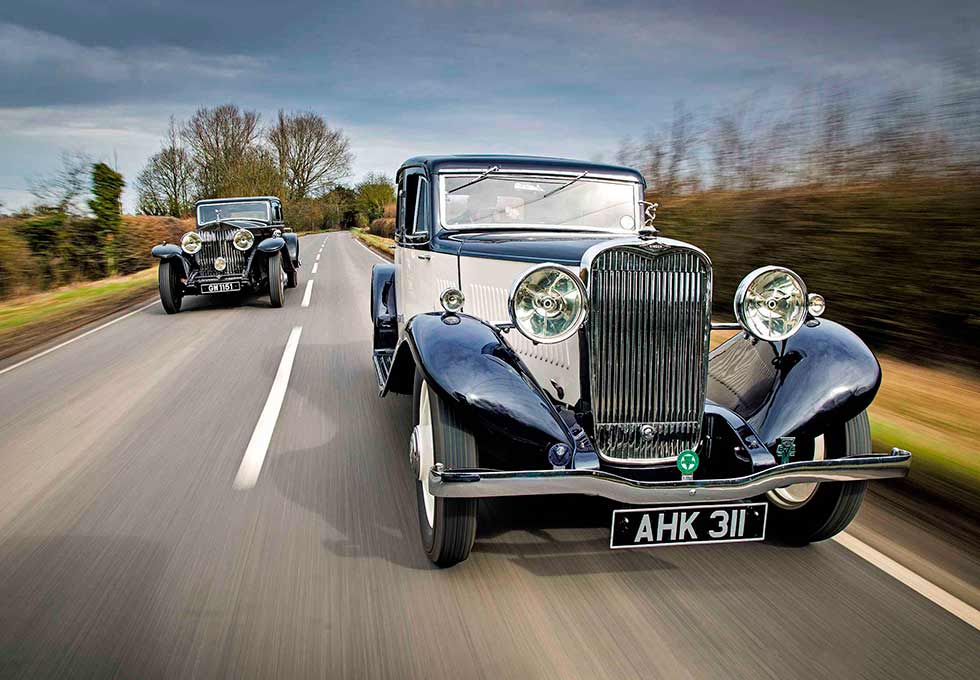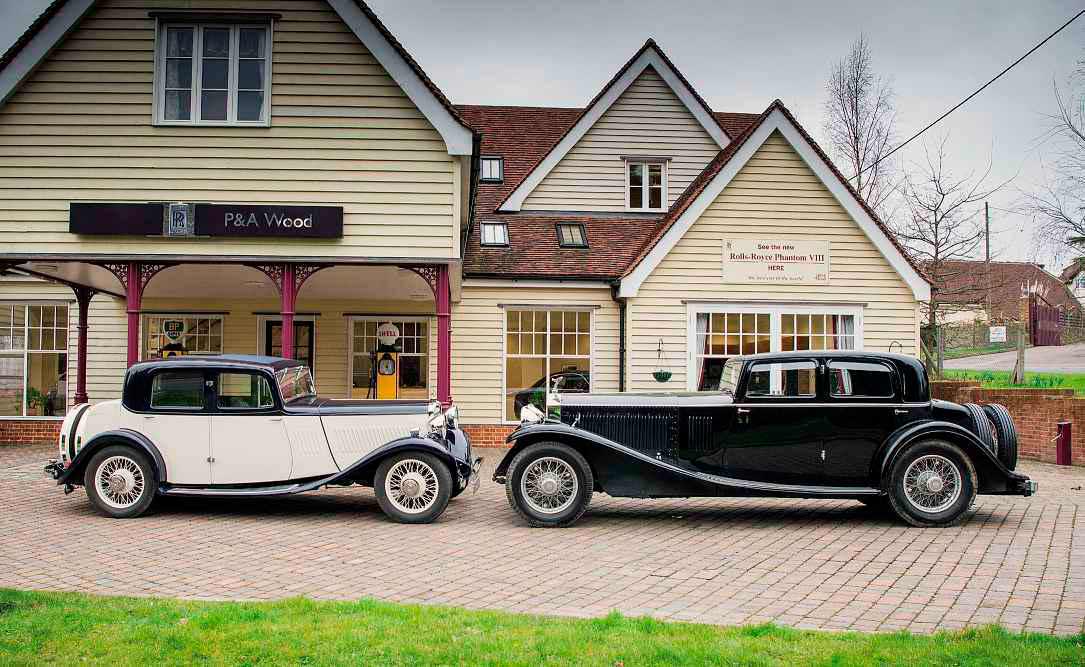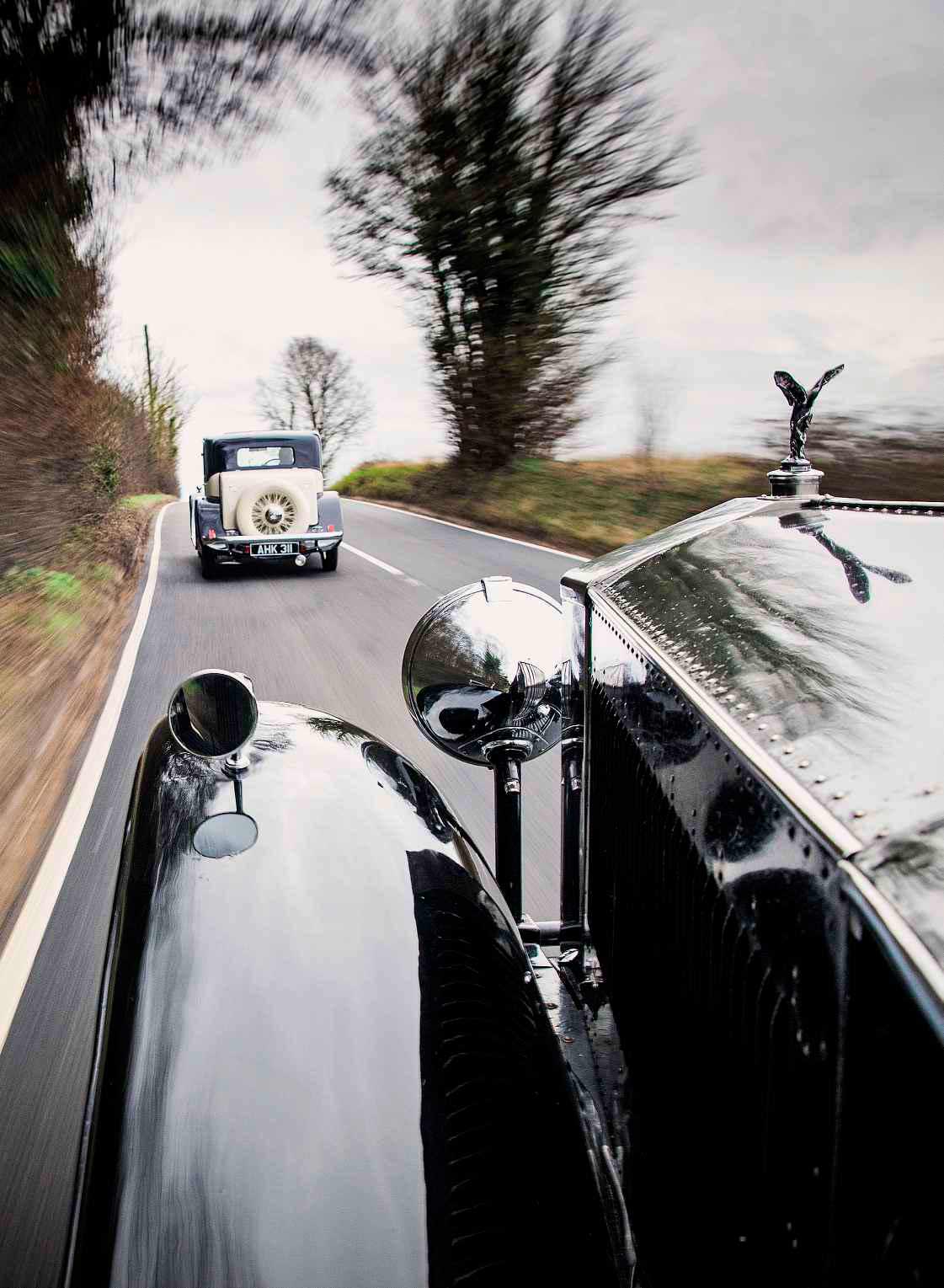
The Kaye Don Rolls-Royce …meets its mini-me Singer counterpart. Record-breaker Kaye Don commissioned a unique Rolls-Royce – then lent his name to a matching Singer. John Simister drives both. Photography Paul Harmer.
The long and the short of it KAYE DON SALOONS
One of these cars cost £2850 new, in the early 1930s. The other cost £365. Yet from the scuttle back they are remarkably similar. Inside, too, there’s commonality in the blue leather upholstery and the wood furnishings, except that only the cheaper car has a full wooden dashboard.

Both, too, have straight-six engines and 20in wheels. And a mascot atop the radiator, although that’s non-standard in the case of the cheaper car. So, what’s going on? Were the economics of supply and demand, of manufacturing and marketing, really so chaotic in that period between the wars?
The car with the very long bonnet and the very recognisable, very Pantheonic radiator is obviously a Rolls-Royce, in this case a Phantom II Continental Touring Saloon. The other one is a Singer Kaye Don 4-Door Coupé De Luxe. Both have a cabin section of rounded-rectilinear design with a ridge above all the side windows and a not-quite-vertical trailing edge to the rear ones, and both have a boxy-but-rounded boot with two exposed spare wheels beyond it. Their running-boards are broad and longitudinally straked, with the front wings flowing smoothly into them. Louvres abound.
The Rolls-Royce is full of the engineering niceties you would expect of the best car in the world, but the Singer has niceties too – including an engine designed by Sunbeam’s Louis Coatalen, with overhead valves and seven main bearings (like the Phantom) and a twin-choke updraught carburettor. Both have a brake servo and a one-shot chassis lubrication system. How could the Singer, maybe three-quarters the size of the Phantom, cost only an eighth as much?

It’s all down to marketing, and the perceived power of a big name of the time. Kaye Don was an Irish racing driver, racing motorcyclist and breaker of water speed records. In 1928 he won the first Tourist Trophy race to be held on Northern Ireland’s Ards circuit, driving a Lea-Francis Hyper, and he raced ex-works Sunbeams at Brooklands with great success – including, in June 1930, setting a new lap record at 137.58mph in his Sunbeam Tigress. His various speedboat records began during the Harmsworth Trophy race on the Detroit River in 1931 with Miss England II, continued later in the year on Lake Garda with the same boat (by then up to 110.25mph), and culminated in 1932 with a run on Loch Lomond in Miss England III at 119.81mph.
So the man born in Dublin on 10 April 1891 as Kaye Ernest Donsky cut a glamorous figure. Among the trappings of fame was the Rolls-Royce Phantom II Continental he commissioned for himself, guiding coachbuilder Arthur Mulliner in the design of what was to be the only Phantom Continental – the sporting specification in the Phantom repertoire – thus bodied by that particular Mulliner company (not to be confused with HJ Mulliner, a prolific clothier of Rolls-Royces in later years). It’s the car you see here, signed off by Rolls-Royce on 19 October 1931.

Kaye Don was also a great friend of one WE Bullock, the managing director of Singer and Co in Coventry. The two hatched a plan to put Don’s name to one of Singer’s larger saloons, a bulbous-looking machine bodied by Beauvais, but these were not a success. So, with their imaginations perhaps fired to greater heights over a convivial dinner, they tried something else: a sporting-looking Singer, based on the six-cylinder Two Litre range, featuring a rakish saloon body in the style of Don’s Phantom.
Their new creation would be lavishly equipped, fitted with various sporting enhancements to set it apart from the regular Two Litre, and sold at a remarkably tempting price as the Singer Kaye Don Coupé. Why ‘Coupé’? Because it was lower and racier than the more prosaic Two Litre, ‘cut’ down a little in profile.
Publicity material was duly created for the launch late in 1932: ‘Progress Never Before So Emphasised…’ declared one brochure. But few were made, even if you include the facelifted version for 1934 that dropped the Kaye Don name in favour of, yes, Silent Six Continental Coupé. ‘You’ll be comfortable at “70” in the Silent Six Coupé’, the brochure said. The first Kaye Don Coupé was given to Bullock’s daughter Marjorie as a wedding present. The second and third were sent to two Singer main dealers owned by works racing drivers, one of which was Westwood Motors in Clacton-on-Sea, Essex, which sold the Kaye Don Coupé on these pages to an army officer in May 1933.

This car is the only Kaye Don Coupé (out of probably five built) known to have survived, and for years its owner, David Freeth, has wanted it to meet the car that inspired it. Today that has finally happened, and it turns out that its owner has been just as keen to see the Singer. The Phantom’s owner is Paul Wood of Rolls-Royce and Bentley restoration specialist P&A Wood, and he’s lent me his car for the day.
At first, Paul wasn’t sure he wanted me to drive it, given how obviously unrestored (and therefore fabulously patinated) it is. The cars in P&A Wood’s showrooms are wonderful examples of Rolls-Royce and Bentley artistry; the company has restored such significant cars as the Rolls-Royce ‘Experimental Speed Car’, which in 1911 drove from London to Edinburgh and back in top gear, and did so again a century later, and the Phantom III saloon with the reverse-rake windscreen that was commissioned from HJ Mulliner by the De Havilland aircraft company’s Alan Butler and used by Field Marshal Montgomery during World War Two.
Paul’s Phantom Continental isn’t quite to this standard. It’s more representative of a car at the beginning of the P&A Wood process than at the end of it, but it’s fully functional and it oozes history. ‘It needs to be gone through mechanically,’ Paul says, ‘but I think it would be a shame to restore it.’ And as it’s Paul’s own car, and not a company asset to sell, he is at liberty to keep it exactly as he likes.
So, happy that I appreciate the Phantom for what it is and that I don’t expect it to be ‘to P&A Wood standard’, Paul takes me for a quick demonstration run, explains what various knobs and levers not found in a modern car are for, and leaves me to it. Me, on my own, in the uniquely bodied 1931 Phantom II that Paul has owned not once but twice, for 30 years in total. ‘I never wanted to sell it,’ he says, ‘but for some reason I did and I immediately regretted it. I bought it back 15 years ago.’
Being a Continental, this is the fastest car in the Rolls-Royce range. It has a slightly racier camshaft, a lowered steering column to go with the lower build, stiffer leaf springs and additional friction suspension dampers to supplement the efforts of the standard hydraulic units. Its monstrous engine has a capacity of 7668cc distributed between six undersquare cylinders. The valves within the crossflow cylinder head, aluminium like the separate crankcase, have their tappets set with a clearance of only 0.003in for maximum quietness, and the compression ratio is just 5:1 for maximum smoothness.
Power? No idea, but presumably adequate. The ignition switch offers a variety of options for the production of electrons, of which the one that employs both the magneto and the coil, while also charging the battery, is favourite and keeps all 12 spark plugs busy. The starter pre-engages, like a modern car’s, so there’s no unseemly crashing of ring-gear teeth as I press the aluminium button and the engine swishes discreetly to life. There’s no tachometer – a modern Rolls-Royce is similarly guarded in its disclosure – but with torque available from almost no rpm it hardly matters.
Nor is there any synchromesh, so the silence of the shifts enacted by the lever hard up against my right shin is down to me. But there’s a lovely oily precision to the way it moves, and the accelerator is obligingly responsive, so double-declutching and rev-matching soon flow nicely. This economy of effort is matched by the big brakes, three-quarters of whose efforts are provided by the ‘friction-type’ servo driven from the propeller shaft.
The steering effort is down to me alone, but it’s not as hefty as you might expect. That applies to the whole car, actually; it looks quite vast, but it’s surprisingly agile and directionally obliging, so it seems usefully smaller than it is. And with that torque, it gets along with a pace similarly unexpected. A sporting Rolls-Royce indeed; you can surprise a lot of other road users as you aim this motor car’s long, anhedral prow at the horizon, the Spirit of Ecstasy’s wings adding a few ounces of downforce as the car proceeds ever more rapidly.
The Singer looks much like this Rolls-Royce, and its coachwork and furnishings are made and finished to as high a standard even if its mechanicals are less intricately engineered. What it lacks in ornateness of door-capping sculpting it counters with neat quarter-rotating dashboard drawers, while both cars have rear armrests and door pockets and flaunt flamboyantly curved doorhandles outside and in. There’s rather less rear seat space in the Singer, but its front seats are more enveloping.
And, unlike the Phantom, the Singer has been restored. David did nearly all of it himself, having sprung it from its barn lair in 1976 and eventually getting stuck into the deep-rooted renovation in the 1990s. One important improvement in the engine was to replace the Duralumin connecting rods with modern steel Phoenix items, which makes me feel a lot happier about approaching that comfortable ‘70’.
Well, I don’t actually get as far round the speedometer scale as that because, despite its six cylinders and 2160cc, the engine manages only 47bhp. So hills are a bit of a hindrance to the heavy, solidly built Singer’s progress, and recovery on the subsequent level takes time. It will eventually cruise happily at 55mph or so, though, the discus-thrower on the radiator cap adding visual momentum, the engine humming a deep straight-six note that makes it sound more sporting than it really is.
As in the Phantom, there are four unsynchronised forward gears, but here they are selected by a long lever conventionally placed in the centre. First is so low that it’s entirely acceptable to start in second unless you’re pointing uphill. But it’s in the chassis dynamics, if that’s not too racy a term, that the Singer’s relative lack of deep-rooted aristocracy shows the most. Its structure feels tight and together, but the steering is springier and much less accurate than the Phantom’s and the sense of unlikely agility is absent. The rod-actuated brakes are less reassuring, too, despite their Dewandre servo.
Then you remember, again, the price difference, and you marvel, again, at how the Singer can be as imposing-looking and as lavishly furnished as it is, at how close it gets to being a downsized Rolls-Royce of sporting ambience. No wonder Singer went under; more surprising is that it held out until the mid-1950s before the Rootes Group picked up the pieces.
And Kaye Don, whose name was dropped by Singer in 1933? That could almost have been prescience on Singer’s part, given what happened in 1934 when Don was testing his MG Magnette on the Isle of Man prior to the summer’s TT race. The steering was not to his liking during the morning session, so an MG mechanic, Francis Tayler, worked on it through to the evening and declared it ready. Don took the MG for another test drive, with Tayler aboard, and hit a taxi as he rounded a bend. The MG overturned and both Don and Tayler were badly injured, although the taxi’s occupants were unharmed.
Tayler died in hospital the following morning, leading to a manslaughter trial for Don. He was found guilty and lost his appeal, but was released in the December on medical grounds resulting from his injuries. Don went on to establish the Ambassador motorcycle company in the 1940s, which was taken over by another small British motorcycle-maker, DMW, in 1962 when Don retired. He also imported Pontiacs through his US Concessionaires company.
Kaye Don died in 1981, but history remembers him for his speed-driven exploits. And, less famously but equally intriguingly, for this bold project to sell an almost-Rolls at an eighth of the cost of the real thing.
THANKS TO P&A Wood, www.pa-wood.co.uk.
Tech and photos
‘Remember the price difference and you marvel at how imposing and lavishly furnished the Singer is’
‘The Rolls-Royce is full of the niceties you would expect, but the Singer has niceties too’
Right and facing page Period publicity from both ends of the market, though this Singer was special in its own right; similar styling, yet the Rolls cost eight times as much as the Singer. Below and facing page Lengthy bonnet a defining Rolls-Royce Continental characteristic; silentrunning straight-six; beautifully patinated interior offers understated luxury.
Above and below Long-bonnet proportions, straight-six and blue leather make the Singer a smaller match for the Rolls – though only the Singer features a full wooden dashboard.
TECHNICAL DATA FILE SPECIFICATIONS 1933 Singer Kaye Don Coupé
Engine 2160cc straight-six, OHV, iron block and head, twin-choke updraught Solex carburetor
Max Power 47bhp @ 3400rpm
Max Torque Not disclosed
Transmission Non-synchronised four-speed manual, rear-wheel Drive
Suspension Front and rear: beam axles, semi-elliptic leaf springs, hydraulic lever-arm dampers
Steering Worm and nut
Brakes Drums
Weight Not disclosed
Performance Not disclosed
TECHNICAL DATA FILE SPECIFICATIONS 1931 Rolls-Royce Phantom II Continental
Engine 7668cc straight-six, OHV, iron block, aluminium crankcase and head, twin-jet Rolls-Royce downdraught carburettor fed by Autovac
Power and torque Not disclosed
Transmission Non-synchronised four-speed manual, rear-wheel drive
Suspension Front and rear: beam axles, semi-elliptic leaf springs, hydraulic and Hartford friction dampers
Steering Worm and nut
Brakes Drums
Weight Not disclosed
Performance Not disclosed






